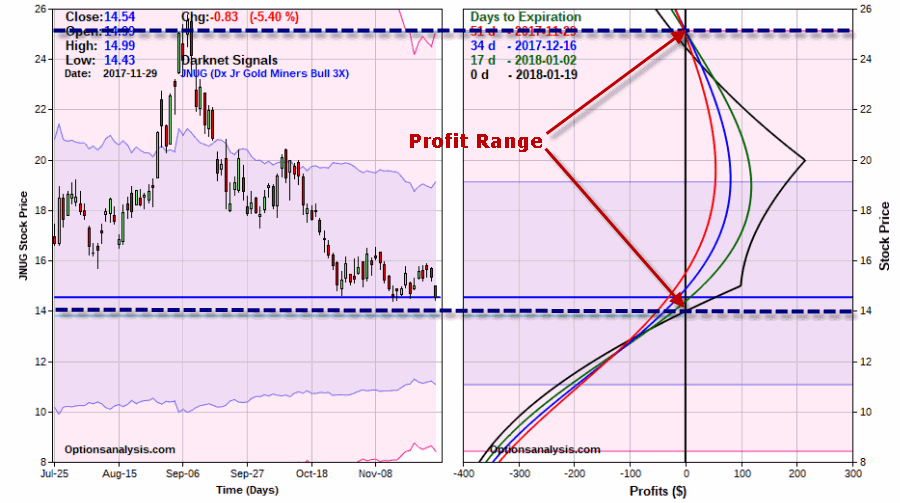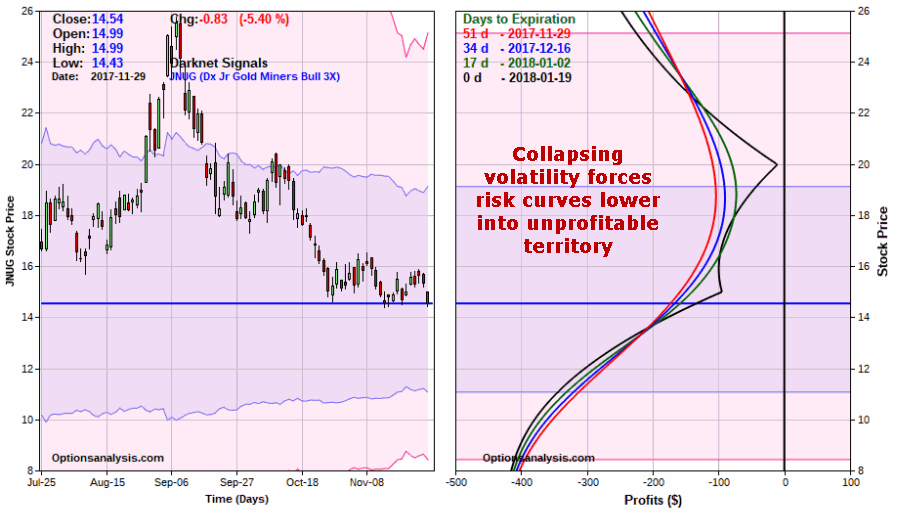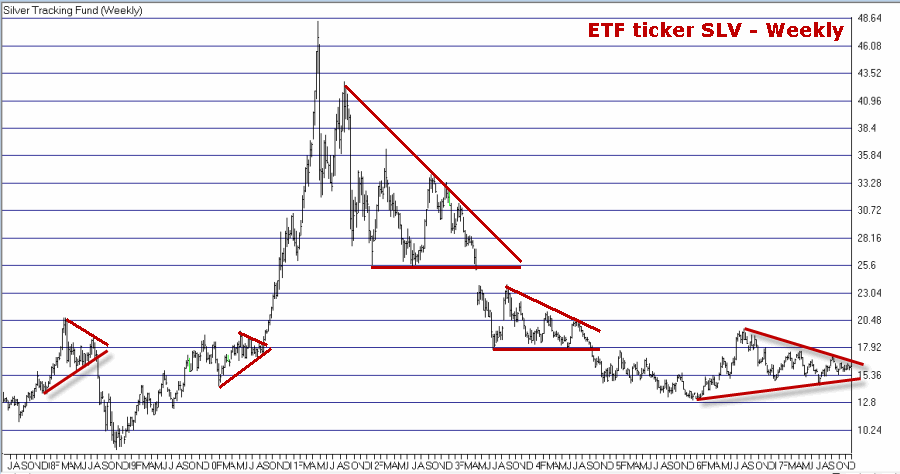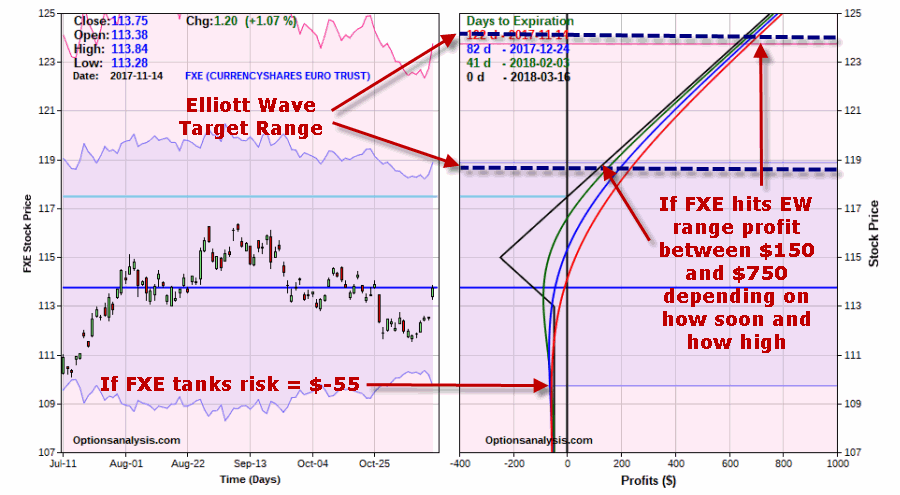Many option traders spend a lot of time focusing on volatility. And rightly so. There is the volatility of the underlying security itself and there is the “implied volatility” of the options on that security. It can make a big difference to know when volatility “goes to extremes”. Let’s illustrate this with an example.
(See also The Critical Importance of Understanding Risk (and Risk Control))
Ticker JNUG
Ticker JNUG is the Direxion Junior Gold Miners Bull 3x ETF. It tracks the MVIS Global Junior Gold Miners Index of gold mining stocks using leverage of 3-to-1. In other words, if the index rises 1% today then JNUG should rise 3%. Our starting point is a double calendar spread involving the following positions:
*Buy 1 Jun 2018 JNUG 15 call @ 3.65
*Buy 1 Jun 2018 JNUG 20 call @ 2.41
*Sell 1 Jan 2018 JNUG 15 call @ 1.43
*Sell 1 Jan 2018 JNUG 20 call @ 0.36
IMPORTANT: As always, this position is an “example” and NOT a “recommendation.”
The initial particulars and risk curves are displayed in Figures 1 and 2. Figure 1 – JNUG Double Calendar Spread (Courtesy www.OptionsAnalysis.com)
Figure 1 – JNUG Double Calendar Spread (Courtesy www.OptionsAnalysis.com) Figure 2 – JNUG Double Calendar Spread risk curves (Courtesy www.OptionsAnalysis.com)
Figure 2 – JNUG Double Calendar Spread risk curves (Courtesy www.OptionsAnalysis.com)
Note that as initially configured the trade will show a profit if JNUG is anywhere between $13.80 and $25.08 at January option expiration on 1/19/2018. In Figure 2 this range looks pretty wide. However, when you look at it on wider price chart as in Figure 3, suddenly the profit range does not look quite so wide. But the real driving force behind this trade is implied volatility. Figure 3 – JNUG (Courtesy ProfitSource by HUBB)
Figure 3 – JNUG (Courtesy ProfitSource by HUBB)
Implied Volatility on JNUG Options
Figure 4 displays 500 trading days of data for ticker JNUG along with the average implied volatility for 90+ day options on JNUG. Figure 4 – JNUG price and Implied Volatility for 90+ day options (black line) (Courtesy www.OptionsAnalysis.com)
Figure 4 – JNUG price and Implied Volatility for 90+ day options (black line) (Courtesy www.OptionsAnalysis.com)
Note that IV is at the extreme low end of the range. The big question is “where to from here”. We already saw in Figure 2 what will happen if IV remains unchanged. But what if IV continues to collapse? And what if it spikes higher instead?
The Impact of a Decrease in Implied Volatility
Let’s assume that between now and January option expiration, IV falls another 30% from current levels. This is probably unlikely but is useful in illustrating the effect of changes in implied volatility. Because longer term options are much more sensitive to changes in volatility (because longer term options have more time premium built into them) the June options will lose more value than the January options resulting in the risk curves you see in Figure 5. Figure 5 – If IV collapses 30% from current level profit potential disintegrates (Courtesy www.OptionsAnalysis.com)
Figure 5 – If IV collapses 30% from current level profit potential disintegrates (Courtesy www.OptionsAnalysis.com)
MAKE THIS IMPORTANT MENTAL NOTE: If you enter a calendar spread and volatility subsequently declines, your potential to make money will be severely – and negatively – impacted.
The Impact of an Increase in Implied Volatility
Now let’s look at what would happen if IV reverses course and “spikes” 30% higher from current levels. The risk curves for this scenario appear in Figure 6. Figure 6 – If IV spikes 30% from current levels profit potential rises and profit range expands significantly (Courtesy www.OptionsAnalysis.com)
Figure 6 – If IV spikes 30% from current levels profit potential rises and profit range expands significantly (Courtesy www.OptionsAnalysis.com)
Note that if JNUG IV increased by 30%, the “profit range” for this trade would expand greatly – to $12.12 a share on the downside and $31.69 a share to the upside.
Summary
As always, it is important to emphasize that I am not “recommending” this trade. It is presented solely as an example to highlight the potentially large implications of changes in implied volatility when utilizing certain strategies.
What we have seen here is that a calendar spread:
*Is best entered when IV is already low
*Will suffer if IV subsequently declines
*Will benefit if IV subsequently rises
Jay Kaeppel
Disclaimer: The data presented herein were obtained from various third-party sources. While I believe the data to be reliable, no representation is made as to, and no responsibility, warranty or liability is accepted for the accuracy or completeness of such information. The information, opinions and ideas expressed herein are for informational and educational purposes only and do not constitute and should not be construed as investment advice, an advertisement or offering of investment advisory services, or an offer to sell or a solicitation to buy any security.































